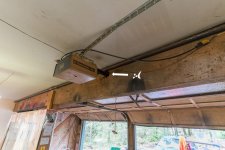ryanjg117
Member
- Joined
- May 18, 2015
- Messages
- 329
Woke up on Saturday and observed my garage door openers weren't working. Realized the new outlets I put in for my new jackshaft openers were dead. Using my voltage tester, I noticed the Romex I tapped for the new outlets was also dead. Unfortunately, it goes into a wall in the garage and I don't know exactly where it goes from there, but I know we have a few other outlets on the same circuit going all the way into our living room. I walked around and it appeared all outlets on this circuit were operating fine. Pretty stumped as I haven't made any changes that could have caused this... No new appliances on the circuit, no new outlets except the ones I added for these openers weeks ago, and no history of intermittent electrical issues.
Went to the main panel and popped off the cover. Looked good and my voltage tester showed the breaker on the circuit was delivering power just fine. I did hear some faint buzzing, about once every ten seconds, but no way I could really know what component in the panel was causing this. It's an early 80s GE panel with no mains switch off (I guess it has a series of top mounted breakers that need to be switched off, not really familiar with this style).
Out of ideas, I went to the hardware store and purchased a few replacement 15a breakers. Was planning to install them this morning when I walked into the garage and, well, the garage door openers were working just fine.
So, either I dreamed this problem yesterday, or the house is haunted.
My question: could a faulty breaker energize just part of a circuit? I know 99% of these issues are caused by a bad wiring connection inside of an outlet or light switch, which could certainly still be the culprit here.
Went to the main panel and popped off the cover. Looked good and my voltage tester showed the breaker on the circuit was delivering power just fine. I did hear some faint buzzing, about once every ten seconds, but no way I could really know what component in the panel was causing this. It's an early 80s GE panel with no mains switch off (I guess it has a series of top mounted breakers that need to be switched off, not really familiar with this style).
Out of ideas, I went to the hardware store and purchased a few replacement 15a breakers. Was planning to install them this morning when I walked into the garage and, well, the garage door openers were working just fine.
So, either I dreamed this problem yesterday, or the house is haunted.
My question: could a faulty breaker energize just part of a circuit? I know 99% of these issues are caused by a bad wiring connection inside of an outlet or light switch, which could certainly still be the culprit here.

